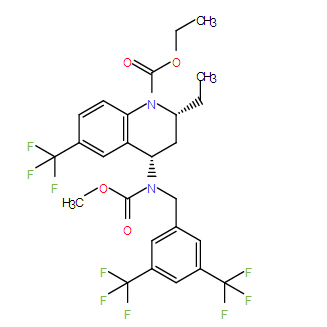| Description: |
Torcetrapib(CP-529414) is a CETP inhibitor with IC50 of 37 nM, elevates HDL-C and reduces nonHDL-C in plasma. |
| Target: |
IC50 value: 37 nM [1]
Target: CETP inhibitor |
| In Vivo: |
Torcetrapib (< 100 mg, daily) changes the plasma distribution of CETP, as the apparent molecular weight of the CETP has shifted to a larger form, by 2 hours after the dose in healthy young subjects. Torcetrapib treatment with 10 mg, 30 mg, 60 mg, and 120 mg daily and 120 mg twice daily results in 16%, 28%, 62%, 73%, and 91% increases in plasma HDL-C, respectively, with no significant changes in TPC in healthy young subjects. [1] Torcetrapib results in an increase of 72.1% in high-density lipoprotein cholesterol and a decrease of 24.9% in low-density lipoprotein cholesterol, in addition to an increase of 5.4 mm Hg in systolic blood pressure, a decrease in serum potassium, and increases in serum sodium, bicarbonate, and aldosterone, in patients at high cardiovascular risk after 12 months' treatment [3]. Torcetrapib (90 mg/kg/day) results in a 70% inhibition of CE transfer in rabbits fed an atherogenic diet. Torcetrapib (90 mg/kg/day) increases mean HDL-C levels by above 3-fold and apoA-I levels by 2.5-fold in plasma in rabbits fed an atherogenic diet. Torcetrapib-treated animal has a multiple-fold increase in HDL-C AUC and a corresponding reduction in aortic lesion area with 60% reduction of aortic free cholesterol (FC) and cholesteryl ester (EC) in rabbits fed an atherogenic diet. Torcetrapib-treated rabbits stimulate free cholesterol efflux to a significantly greater extent than does sera from control rabbits [4]. |
| In Vitro: |
Torcetrapib dose-dependently increases aldosterone release from H295R cells after either 24 or 48 h of treatment with an EC50 of approximately 80 nM, this effect is mediated by calcium channel as calcium channel blockers completely blocks torcetrapib-induced corticoid release and calcium increase. Torcetrapib (1 μM) significantly increases the expression of steroidogenic gene, CYP11B2 and CYP11B1, in H295R cell lines [2]. |
| References: |
[1]. Clark RW, et al. Raising high-density lipoprotein in humans through inhibition of cholesteryl ester transfer protein: an initial multidose study of torcetrapib. Arterioscler Thromb Vasc Biol. 2004 Mar;24(3):490-7.
[2]. Hu X, et al. Torcetrapib induces aldosterone and cortisol production by an intracellular calcium-mediated mechanism independently of cholesteryl ester transfer protein inhibition. Endocrinology. 2009 May;150(5):2211-9.
[3]. Barter PJ, et al. Effects of torcetrapib in patients at high risk for coronary events. N Engl J Med. 2007 Nov 22;357(21):2109-22.
[4]. Morehouse LA, et al. Inhibition of CETP activity by torcetrapib reduces susceptibility to diet-induced atherosclerosis in New Zealand White rabbits. J Lipid Res. 2007 Jun;48(6):1263-72. |






















